Basilica in the Bush: Chittering parishioners called to be a community of disciples of Christ
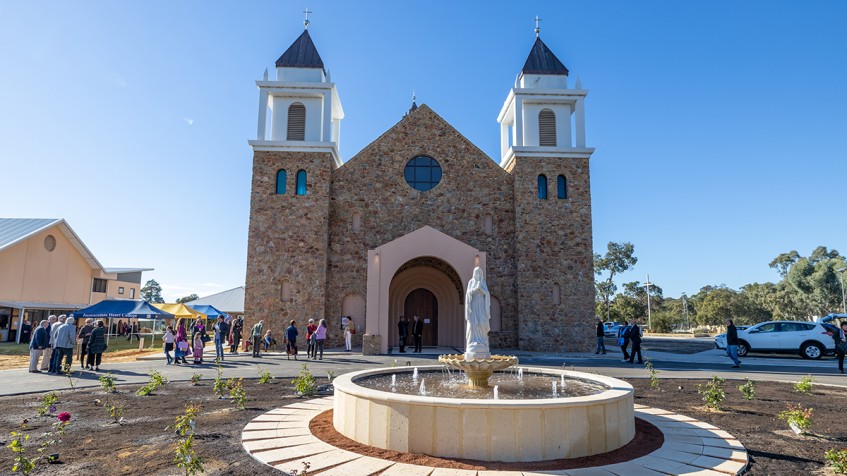
The new Romanesque style Church of the Divine Mercy was designed by Peter Anthes and built by Rodney Naef. Photo: Max Hoh.
By Jamie O'Brien
Perth Archbishop Timothy Costelloe SDB has last weekend celebrated the Dedication Mass of the Church of Divine Mercy in Lower Chittering, calling on the parish community to be a healer of people’s wounds and warmer of people’s hearts.
An important piece of history in the Archdiocese of Perth unfolded last weekend Sunday 6 June with the Dedication Mass of the new Divine Mercy Church in the parish of GinGin Chittering.
The Romanesque style Church, built thanks to the donations of parishioners and benefactors near and far, was designed by local draftsman Peter Anthes and built by Rodney Naef.
More than 850 people lined the pews and outdoor areas for the two-hour special occasion, on the Solemnity of the Body and Blood of Christ, celebrated by Archbishop Timothy Costelloe SDB.
Speaking during his homily, Archbishop Costelloe, spoke of three thoughts, or gifts, for the congregation to remember.
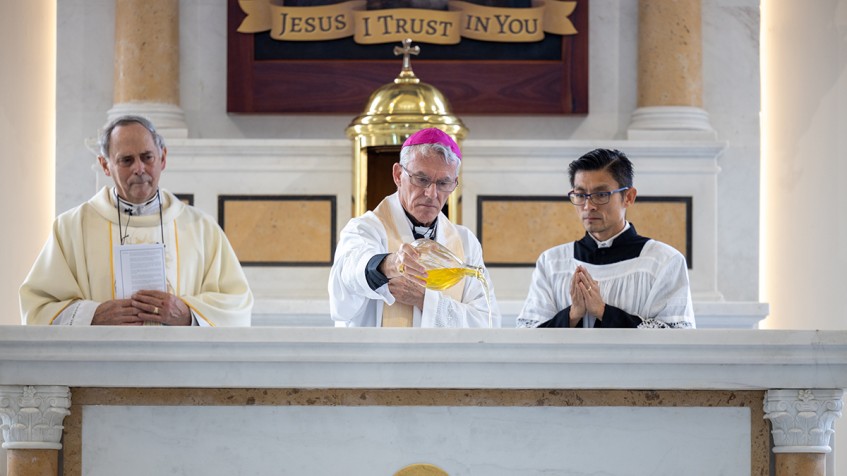
Archbishop Costelloe pours the Oil of Chrism on the Altar during the Dedication Mass of the Church of the Divine Mercy on Sunday 6 June. Photo: Max Hoh.
“The first comes to us from the authority voice of the Church with the Second Vatican Council. When in one of the major documents of that council, Lumen Gentium, the Church Fathers spoke of what the Church is really all about.
“The Church is like a sacrament, that is the Church is a sign and an instrument of two things - communion with God and of unity among God's people.
“At the end of each day, if we wanted to examine how our day had gone, we might well ask ourselves, what part did I play today in showing that the Church is all about drawing ever more deeply into communion with God and also drawing ever more deeply into communion especially with my brothers and sisters in the faith,” Archbishop Costelloe asked the congregation.
Archbishop Costelloe continued by speaking about St John Paul II, as the ‘Pope of Divine Mercy.’
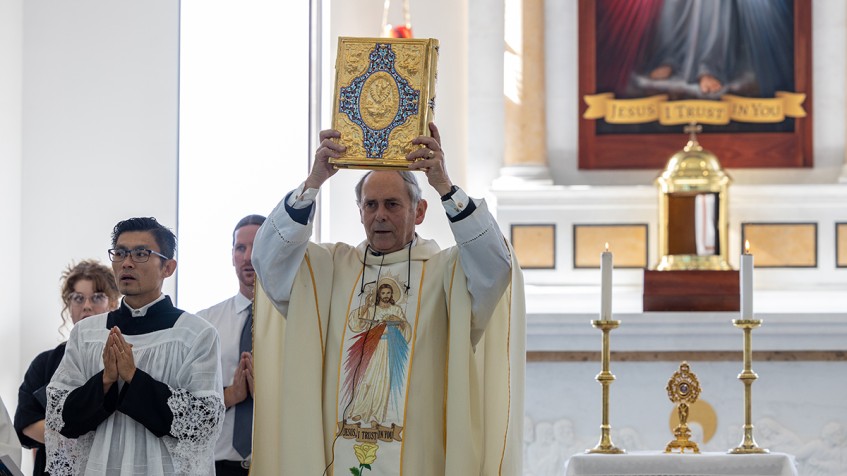
GinGin Chittering Parish Priest Fr Paul Fox carries the book of the Gospels to the lectern to proclaim the Gospel during the Dedication Mass of the Church of the Divine Mercy on Sunday 6 June. Photo: Max Hoh.
“He had one favourite expression that he used over and over again,” Archbishop Costelloe said.
“He said, ‘The Church is the community of disciples of Christ’. It’s such a simple idea, and yet again it’s so rich in meaning. The church is a community, not a gathering of isolated, independent people, but a community of people who are disciples of Christ.
“And that means that we as a people know that rather than looking to each other, or only to each other, rather than looking to our own strengths and skills and talents, ultimately, we have to look to Christ.
“Because we are his disciples, we follow him no one else. No one else. No other philosopher, no other politician, no other leader, we follow Christ and we build our lives on Him. And if this church, this church building, is to fulfill its potential, it will need to be a place where the only person ultimately upon whom we fix our guys, is Jesus himself.”
Joining Archbishop Costelloe for what was his third Dedication Mass in as many as six weeks, was GinGin Chittering Parish Priest Fr Paul Fox, Carlisle Parish Priest Fr Nicholas Perera and Indonesian Catholic Community Chaplain Fr Remi Asnabun together with several other priests from across the Archdiocese.
The next thought, Archbishop Costelloe explained, came from Pope Francis, who referred to the Church as being a field hospital in the middle of a battle.
“Pope Francis went on to say, ‘This is the great mission of the Church today, to be a healer of people's wounds.
“Then he added something - that we need to be not just a healer of people’s wounds, but a warmer of people’s hearts.
“This Church, if it is to fulfill its potential where people can come and find healing of the wounds that are deepest in their lives, certainly, through the sacraments, especially the Sacrament of Reconciliation and the Sacrament of the Eucharist, but also through the community that gathers here.
“We need to be people who both come here for our own wounds to be healed, and come here so that we can help heal the wounds of others.
“Because that after all, is what being a disciple of Christ looks like.”
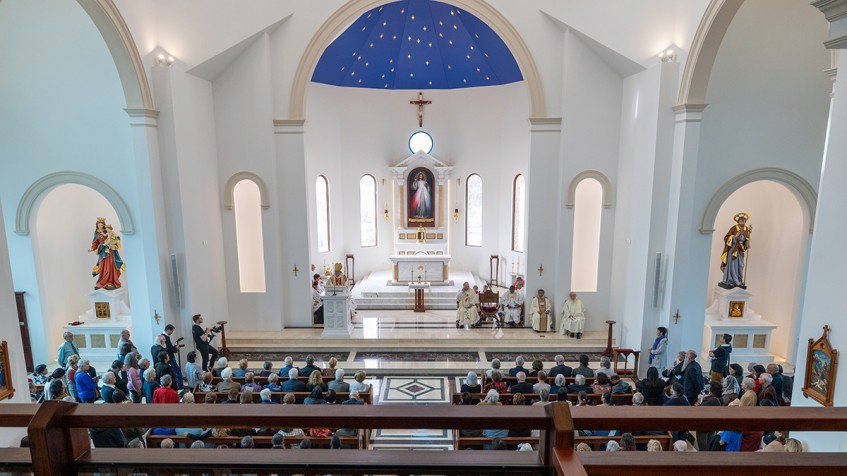
Hundreds from near and far gathered for the Dedication Mass of the Church of the Divine Mercy on Sunday 6 June. Photo: Max Hoh.
Speaking at the conclusion of Mass, Fr Paul Fox paid tribute to the many benefactors and parishioners who had contributed to the building of the new Church.
“What a wonderful day of joy for all of us, as this magnificent Church is finally dedicated after our tenth year now; our work has finally come to completion, our Lord has finally brought it to completion,” Fr Fox exclaimed.
“The inspiration behind building this church in honour of Divine Mercy here in Western Australia was not only to cater for the needs of the parish, but to provide the numerous Divine Mercy prayer groups and the faithful of the Archdiocese of Perth with a beautiful and uplifting place of pilgrimage,” he said.
“As a sanctuary of prayer and healing where all could come and be spiritually renewed at the foot of the Divine Mercy image.”
Speaking exclusively to The Record, designer Peter Anthes, who also designed the Church of St Anne’s in Bindoon, said he drew upon the best traditions in Church architecture, using an inspiring copper domed cruciform stone Church, which would be an icon of faith and a desirable pilgrimage destination.
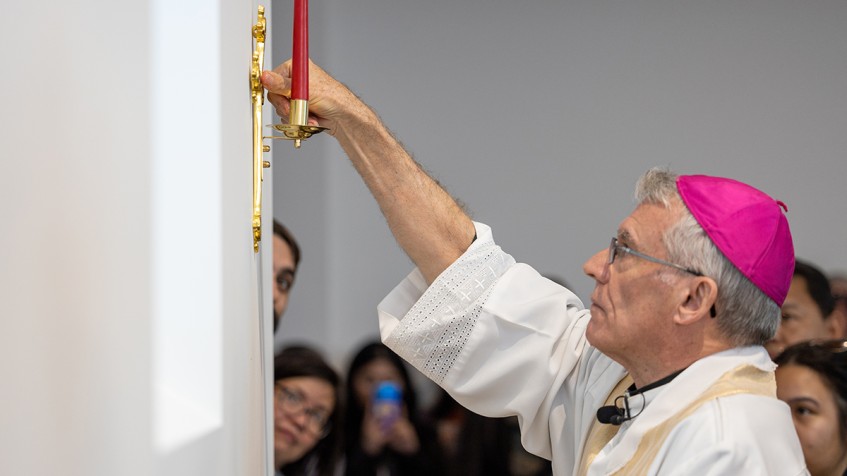
Archbishop Costelloe anoints a cross during the Dedication Mass of the Church of the Divine Mercy on Sunday 6 June. Photo: Max Hoh.
“The Church is set in the beautiful Chittering Valley which is already a very popular destination for visitors,” he said.
“I added a dome because of the size of the Church, as well as the attraction it has and to increase light,” Mr Anthes said.
“I researched many buildings and churches from around the world, this is a practical style that will support the liturgy in an uplifting way.
“It has been a great opportunity to grow in experience as a designer,” Mr Anthes concluded.
